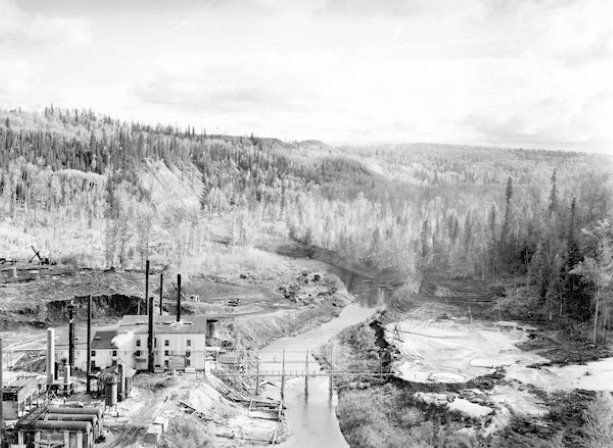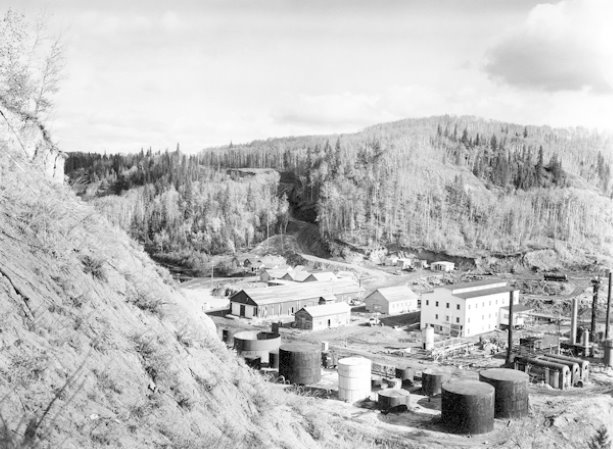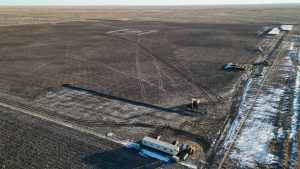The remnants of Abasand Oils Ltd. are located just a kilometre or so west of Fort McMurray’s Abasand Heights neighbourhood. Just follow the trail on foot, but wear rubber boots; the tarry oilsands can ruin a pair of good shoes on a hot day. In three-quarters of an hour, you’ll spot the remnants of the operation. The plant stopped operating forever in 1945, but remains a milestone in oilsands development — the first plant of its kind to pipe a refined product.
The existence of the oilsands was no secret to indigenous people living in the area centuries ago. The Abasand story begins in 1921 when researcher Dr. Karl Clark was hired by the Alberta government to determine whether the oilsands could be used for paving roads. It couldn’t, but Clark continued to investigate the possibility of deriving crude oil from the deposits. He patented a technique to separate bitumen from the oilsands using hot water in 1928.
The discovery of the new process intrigued American Max Ball, who founded the Canadian Northern Oil Company in 1930 to build a pilot plant. He was plagued by forest fires and suppliers who went out of business following the stock market crash. Undaunted, he found new financing and renamed the company Abasand — a contraction of "Athabasca Sands." A few months later he received Bituminous Sand Permit No. 1 to mine 1,555-hectares, nestling a bend in the Horse River.
Construction of an extraction plant began in 1935 and a pilot plant was completed in 1936. But the abrasive nature of the oilsands dogged the project and caused repeated equipment failure. Instead of excavating the deposits, Ball began to blast them using explosives.
A pipeline was completed in 1940 to transport refined oil to a railroad stop in Waterways, a few kilometres away. However, the difficulty of hiring workers and securing supplies during the Second World War hampered the effort. By the time the plant was finished. Ball and his investors had spent $1 million on research, development and construction.
The plant was running full steam ahead by May 19, 1941. According to Black Gold by Alastair Sweeny, by September, the operation had mined 18,475 tons of oil sand and refined it into more than 42,000 gallons of gasoline, almost 71,000 gallons of diesel fuel and more then 137,000 gallons of fuel oil. However, the separation plant and powerhouse both burned down on November 21, stopping production in its tracks.
With Second World War oil security at the top of its agenda, the Canadian Wartime Oil Administration took over the ravaged plant. Hoping to perfect a cold water extraction process, the federal government contracted General Engineering to rebuild the plant on a larger scale through 1942 and 1943. The plant opened again in 1944.
The Petroleum History Society’s oral history program interviewed Bill Humphreys, who worked at the plant as a young man. He recalls train trips from Edmonton taking 21 hours to reach Waterways. Any supplies delivered by rail had to be further trucked to the Abasand plant.
He also recalls that the plant met the same fate as its predecessor:
"I remember very well when the big fire burned it down," he says.
"I can remember sitting in the house on a Sunday when my father got the phone call that the plant had burned down…apparently, there was a welder doing some repair work up there. This is the word he had, anyway. But anyway, and they had somebody standing there. I mean there’s oil residue all over the place…And, it did catch fire and they couldn’t stop it."
The remnants of the plant seen today don’t fully reveal the extent of the construction: coke houses, separation plants, powerhouses, machine shops, equipment sheds, bunkhouses for as many as 150 workers, a bridge, a rail line and a dam along the river.
The most thorough history of the enterprise was published in 1980 by Fort McMurray resident Darlene Comfort. Its title fully captures the nature of the early enterprise on the banks of the Horse River — The Abasand Fiasco: The Rise and Fall of a Brave Pioneer Oil Sands Extraction Plant. While the company stumbled, its pioneering research helped other energy companies to succeed where it had faltered.











Recent Comments
comments for this post are closed